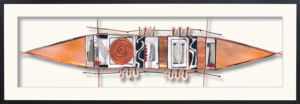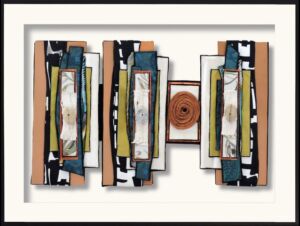
Welcome ALICE VANDER VENNEN from Canada
avril 2, 2023 @ 8:00 am - avril 30, 2023 @ 11:30 am
Welcome Alice Vander Vennen
I work with multiple materials, such as fabrics, branches, wire, copper, paper and ceramic shards, creating an assemblage as part of a visual language .

Timber-Bend by A. Vander Vennen
Artist‘s Statement
« While experiencing the culture and the physical surroundings of Hyères, I would like to create visual poems depicting narratives in color, shapes and form, as reflected back to me from the environment of Hyères.
I would like to work with found textiles and other found objects which are embedded with cultural overtones, seeking to capture the cadence and rhythm of the people and the place.
For me , creating art work is also participating in a dialogue with other people, wether they may be maker, viewers, those who critique. They are all part of the creative process.
It is exciting to think in that new dialogue with people in Hyères and the surrounding area.

Field-Stone by Alice Vander Vennen
Check out for more information about Alice:
excerpt from an interview mentioned on the website (http://www.worldofthreadsfestival.com/artist_interviews/081_alice_vander_vennen_12.htmlWhy did you choose to go into fibre art?
I love fabric because of how rich in information it is. Fabric speaks to so much history. Not only does it have the five elements of art—line, shape, colour, texture, and space—but it also carries such histories. It is imbued with stories of its origins, its maker, its geographic place, its culture—all of those details are « woven » into fabric. So when one works with fabric one immediately has a rich palette of stories, known or unknown.
Also in many cultures, fabric carries the work and the stories of women, so often silent. If we think of the women in our own histories, do we know their stories? What they’ve gone through? What they’ve experienced? Even if we don’t know their stories, there is a good chance that we have access to some of the work that they have created with their hands. Here I think of my own aunt, « Tante Jantje », who at much risk worked in the underground in the Netherlands during World War 2, hiding people of Jewish descent. Even though this dear woman helped raise me, I didn’t hear her full story for many years. So I cherish what she made, for it speaks of who she was. In the same way, I like working with textiles that carry the handprints of so many stories known or unknown.
I also like the medium of fabric simply because it is so available. I trained as a sculptor in the 1970s. I did a lot of welding and bronze casting and worked large-scale. At a certain point I found that those resources were no longer available to me—I had little space, time and resources. It was natural to reach for something so close at hand and so rich in character that would allow me to keep doing my art.
What other mediums do you work in, and how does this inform your fibre work?
Trained as a sculptor, I focused on working with the found object and would create sculpture by assembling these found objects. Found objects still have a prominent place in my work. As an artist, besides sculpture, I have also done a considerable amount of work in ceramic and in tapestry weaving.
